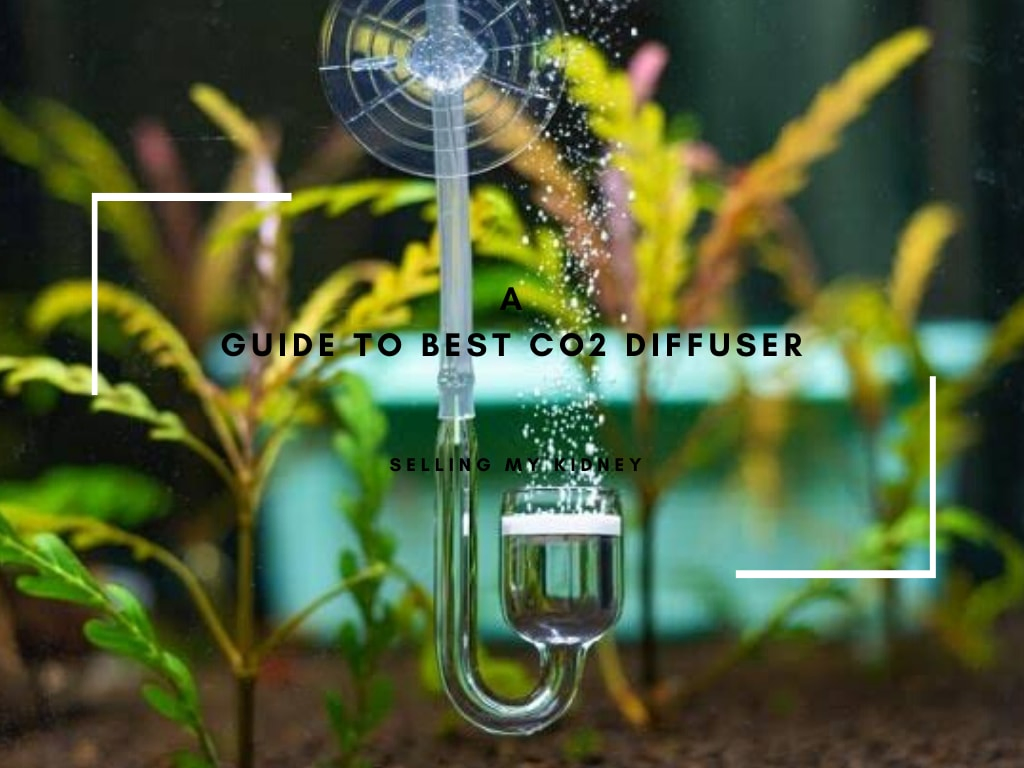A 10-gallon tank is THE basic option for rookie fish keepers. It’s small, simple, and easy to maintain. Assuming that you have already bought (or intend to buy) a 10-gallon aquarium, let’s talk about one must-have attachment – a filter.
Having the best filter for a 10-gallon tank is a must. Otherwise, you’ll end up with algae-covered, nitrogen-rich, poisonous water that will DEFINITELY kill your precious fish.
I understand that you are new to the aquascaping world and that’s why I present you with this extremely newbie-friendly guide to the best filters for 10-gallon tanks.
Not only will I talk about the best options available on the market, but I’ll also discuss every relevant topic related to the best filters for a 10-gallon fish aquarium.
So, let’s get started.
| IMAGE | PRODUCT | DETAILS | rating | price |
|---|---|---|---|---|
Overall Best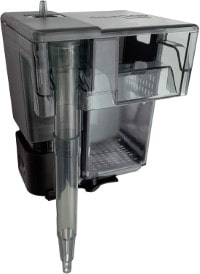 | Aqua Clear – Fish Tank Filter |
| ||
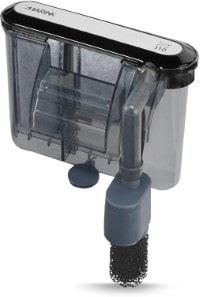 | Marina Power Filter |
| ||
Best for 10G planted tank | Penn Plax Cascade Hang-on Aquarium Filter |
| ||
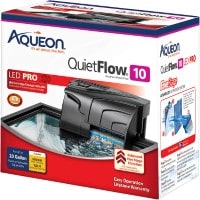 | Aqueon QuietFlow LED PRO Aquarium Power Filters |
| ||
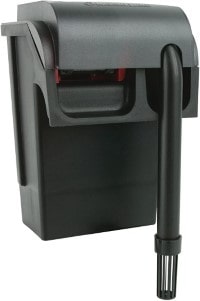 | Marineland Bio-Wheel Penguin 75 Power Filter, 10-Gallon |
|
Does A 10-Gallon Tank Need a Filter?
Yes, it definitely does!
A fish aquarium accumulates different kinds of waste. For example, your fish will waste food, they will poop, and dirt from the environment will enter the water at the surface.
As this waste rots, different kinds of harmful chemicals (ammonia, nitrites, and nitrates from the nitrogen cycle) are produced. As a result, your fish can get sick, and in some cases, die.
Also, you can’t change all the water in the tank as this is very unhealthy for the fish.
What’s the result?
Your aquarium ends up being a death-bed for your fish.
Some people will tell you that only large tanks need filters.
This is a very big mistake!
In fact, smaller tanks accumulate waste even faster than larger tanks. You can skip a lot of other items for your aquarium’s setup, but never the filter.
5 Best Filters for 10-Gallon Tanks – The 2020 Selection
AquaClear – Fish Tank Filter – The Overall Best

AquaClear has an excellent reputation among the fishkeepers and aquarists. They have gained such popularity due to their innovative products and mind-boggling technologies.
AquaClear Power Filter is no exception to this. The HoB type filter is loaded with features.
You get better filtration volume, more water-to-filtration media contact time, and a larger media storage space.
All these great features come at a reasonable price.
Of course, there are better filters available, but you won’t get anything as good as this one in this price range. It’s hands down the best filter for a 10-gallon fish tank.
Product Profile – AquaClear – Fish Tank Filter
- Filter type: Hang-on-back (HoB)
- Capacity: 5 to 20 gallons Tank
- Output: 100 gallons/hour
- Filtration stage: Three-stage
- Filtration media: AquaClear Foam, Activated Carbon Filter and AquaClear BioMax
Notable Features
- Patented re-filtration technology which allows 50% of dirty water to be refiltered multiple times
- Unique CycleGuard multistage filtration offers optimal mechanical, chemical, and biological filtration
- Option to customize filtration media with seven available options, including Zeo-Carb and Ammonia remover
- Filtration volume is 7 times higher than the average options
Marina Power Filter – Best Biological Filtration
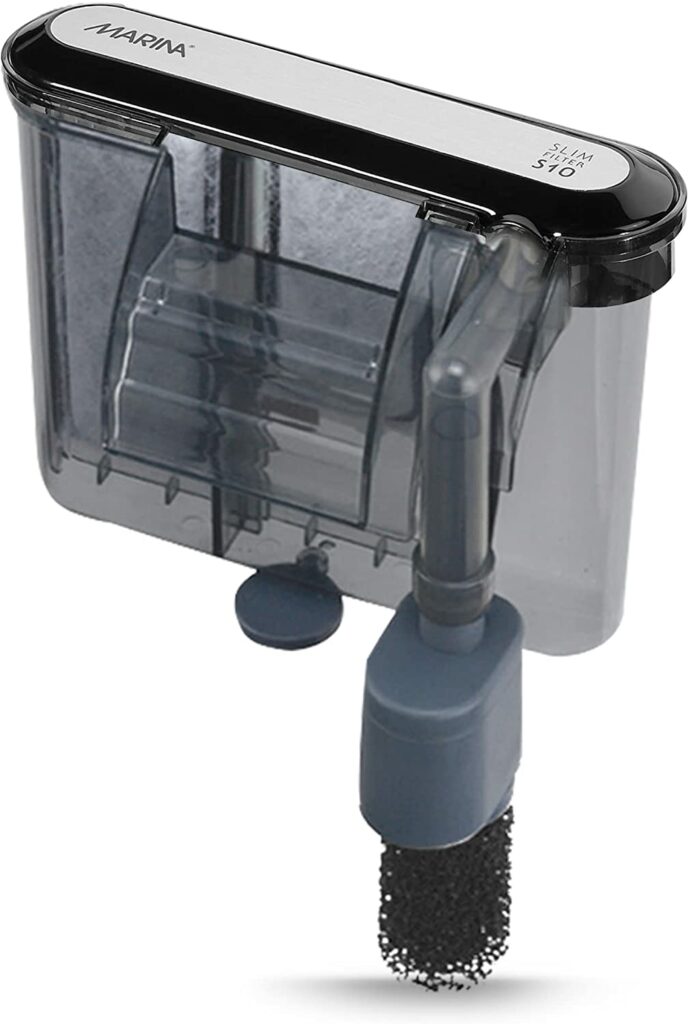
Marina Power Filter is a specialized filter which focuses extensively on biological filtration. That’s why they have added two types of biological filtration media instead of just one – Bio-carb and Bio-Clear.
Both contain Ceramitek, which is a highly porous filtration media.
There are also two other eye-catching features with this product.
The first is that it has adjustable flow control so you can be in charge of whatever happens in your tank. The second is that the filter’s motor is submerged in the water so it makes little to no noise.
Yes, the lack of mechanical and chemical filtration is a negative point, but quality and the flexibility offered by the product is astounding.
In addition, this product offers the highest quality at this price point.
Product Profile – Marina Power Filter
- Filter type: Hang-on-Back (HoB)
- Capacity: Up to 10 gallons
- Output: Variable and adjustable
- Filtration stage: Single-stage
- Filtration media: Bio-Carb and Bio-Clear
Notable Features
- Two types of biological filtration media
- Fully adjustable water flow rate
- Submerged motor offers quieter operation
- Self-priming motor
Penn Plax Cascade 100 Hang-on Aquarium Filter With Quad Filtration System – Best Filter For a 10-Gallon Planted Tank

Sometimes, we want sheer power from our filters, don’t we?
Penn Plax Cascade 100 is one of the most powerful filters in this range for smaller aquariums.
This filter’s unique feature is that it offers four-stage filtration with adjustable water flow. It offers two stages of biological filtration, rather than one, with a separate mechanical and chemical filtration system.
In addition, the filtration media quality is certainly superior to some other brands.
Product Profile – Penn Plax Cascade Hang-on Aquarium Filter
- Filter type: Hang-on-Back (HoB)
- Capacity: 10 to 20 gallons
- Output: 100 gallons/hour
- Filtration stage: Four-stage
- Filtration media: Poly fiber floss, activated carbon, bio-sponge, and bio-falls
Notable Features
- Quad-filtration system with bio-falls
- Adjustable knob to control flow rate
- Self-leveling system
- Adjustable intake tube length
- Disposable, double-sided media cartridges
Aqueon QuietFlow LED PRO Aquarium Power Filters – Quietest Operation

If you are looking for filtration efficiency, let me show you another filter that offers four-stage filtration.
Aqueon QuietFlow LED Pro is capable of wet/dry filtration along with mechanical, chemical, and biological filtration. Also, the filter has a diffuser grid which reduces splashes and makes the process quieter while removing toxins.
The build quality is noteworthy. In addition, Aqueon QuietFlow comes with a unique feature – an LED light that indicates when the filter cartridges need to be replaced.
Product Profile – Aqueon QuietFlow LED PRO Aquarium Power Filters
- Filter type: Hang-on-Back (HoB)
- Capacity: Up to 20 gallons
- Output: 100 gallons/hour
- Filtration stage: Four-stage
- Filtration media: Dense floss, activated carbon, bio-holster, diffuser grid
Notable Features
- Four-stage filtration with wet/dry stage
- Self-priming technology
- Certified 100 GPH flow rate
- LED indicator which tells you when it’s time to change cartridges
- Internal pump that dampens operating sound
Marineland Bio-Wheel Penguin 75 Power Filter, 10-Gallon – Best Budget-Friendly Option
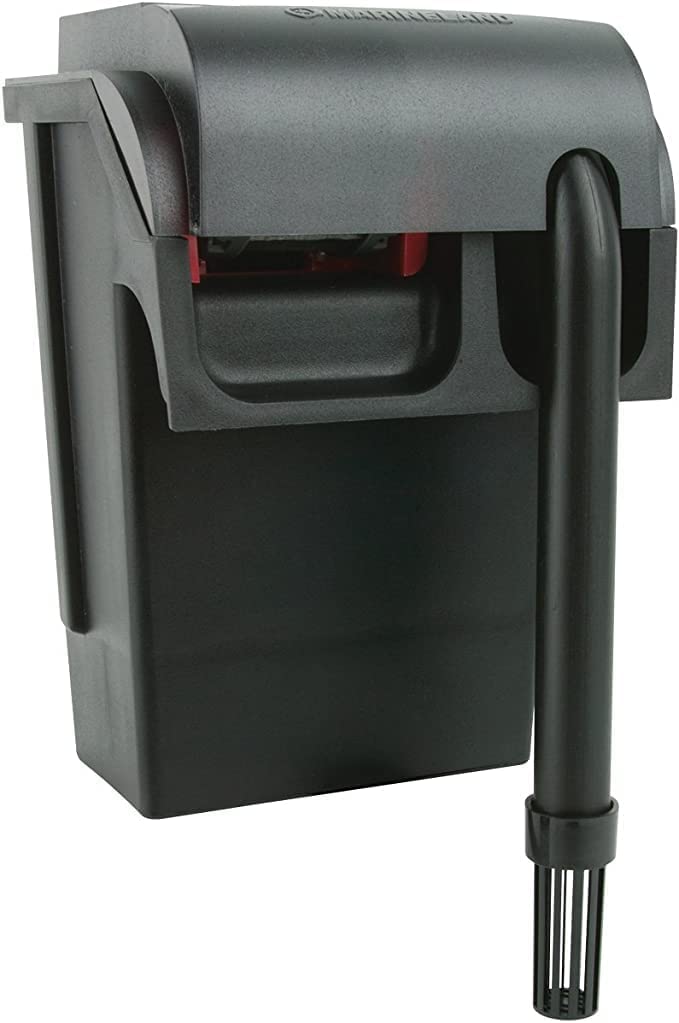
Marineland Bio-Wheel Penguin is a small HoB-type filter which offers three types of filtration.
The manufacturers are very proud of their bio-wheels which act as biological filtration media. I would say that bio-wheels are great. They’re not the best option, but they’re still a great option.
Also, the filter doesn’t have any air pumps, valves, or tubes, which makes it an aesthetically pleasing filter system.
The fact that it doesn’t have any air pumps is both good and bad at the same time. It will not overpower the system, but lacks efficiency.
Product Profile – Marineland Bio-Wheel Penguin 75 Power Filter
- Filter type: Hang-on-Back (HoB)
- Capacity: Up to 10 gallons
- Output: 75 gallons/hour
- Filtration stage: Three-stage
- Filtration media: Sponge, activated carbon, bio-wheel
Notable Features
- Three-stage filtration
- Doesn’t require an air pump, valves or tubing
- Certified 75 GPH flow rate
- Self-priming
What Is the Nitrogen Cycle? – Understanding the Nitrogen Cycle
The number one reason for installing a filtration system in your aquarium is the nitrogen cycle. I think you might have heard about this over and over again from a lot of people.
Why is that?
What’s So Dangerous About the Nitrogen Cycle?
The main culprits are three chemical compounds – ammonia, nitrite, and nitrate. These three compounds are toxic and pose a lethal threat to the fish in your aquarium.
How is this true?
Firstly, ammonia causes ammonia poisoning, which is a common disease. This issue is more prominent in new aquarium systems.
Next comes nitrite, which is probably the most dangerous compound in the nitrogen cycle. This toxic compound enters the system of the fish and binds with the hemoglobin in their blood. The hemoglobin then converts to methemoglobin.
Hemoglobin is an essential element for blood as it carries oxygen and supplies it to the cells, but methemoglobin doesn’t have any such responsibilities.
Therefore, fish can fall victim to Brown Blood Disease.
What about the third one – nitrate?
As with the previous two cases, nitrate also causes nitrate poisoning among fish. If the nitrate concentration increases to a certain level, your fish could even die. In some cases, nitrate poisoning can kill fish in just 24 hours.
Nitrate is the culprit behind another problem – nitrate shock. If the nitrate concentration increases dramatically, fish can go into shock and require emergency treatment.
How Does the Nitrogen Cycle Work and How Are These Lethal Compounds Created?
Everything starts with waste creation. In any ecosystem, waste will be created. It’s only natural.
For example, in a fish tank:
- Fish will excrete
- Food will be wasted (fish won’t eat every single grain of food)
- Plants will shed branches and leaves
As with any ecosystem, this waste will rot – it’s a cleansing process.
Different bacteria have the responsibility of converting this waste. Also, fish discharge ammonia directly when excreting.
This is the first phase where ammonia dominates the water.
Then, different nitrogen-fixing or nitrosomonas bacteria convert ammonia to nitrite through an oxidization process.
As previously mentioned, nitrite is the most dangerous of all three harmful compounds. But the process doesn’t stop here.
Bacteria again converts the nitrite to nitrate.
Nitrate is the final result of the nitrogen cycle. Different fish have a certain level of tolerance to nitrate, but if the nitrate level reaches a certain threshold limit, things can get very dangerous.
There is a natural fix for this scenario – plants. Plants are the only natural solution to the nitrogen cycle as they take in ammonia, nitrite, and nitrate through the nitrogen assimilation process.
However, if the fish vs water volume ratio is imbalanced, plants are not able to save the day. The concentration of nitrogen gasses will be too high.
This is why a filtration system plays such a vital role.
A good aquarium filter will have a chamber which conducts the biological filtration. This section mainly houses a colony of good bacteria which “eat” ammonia, nitrite, and nitrate.
More: Best Filter for Betta fish
Types of Filtration
You are now well aware of the dangers of the nitrogen cycle.
But is this the only dangerous thing which can happen in an aquarium?
NO!
An aquarium contains many kinds of harmful elements in addition to the compounds of the nitrogen cycle.
This includes:
- Large debris (such as uneaten chunks of food)
- Dirt and dust particles from the air
- Water impurities
- Chlorine
- Hard metals in the water
These contaminants will also pose some threats to the fish. An aquarium filter has certain methods which can cleanse the water of them.
That’s why a good filter doesn’t just have one filtration method, but multiple filtration methods. You can classify the filtration methods or types into three categories:
- Mechanical filtration
- Biological filtration
- Chemical filtration
Here are the details of each process:
Mechanical Filtration
A mechanical filtration system handles the physical elements such as large debris and dust particles which don’t dissolve in the water.
A simple sponge can typically complete the task of removing these physical elements.
The water pump sucks in the contaminated water and forces it to pass through the sponge. The sponge then stops the debris and dirt passing through.
This means there is no more visible waste in the tank.
In most cases, mechanical filtration is the first stage of filtration and it helps other filtration systems work properly.
More: Best Filter For Goldfish
Biological Filtration
A biological filtration system mainly performs the responsibilities of removing the harmful elements from the nitrogen cycle.
This is the most important stage of filtration.
Some basic aquarium filters only incorporate this stage of filtration for treating the water.
How does this stage work?
Its main purpose is to create a large colony of denitrifying bacteria. When contaminated water passes through the bacteria, it can reduce the concentration of nitrate, ammonia, and nitrite.
Most filter brands use something called bio-balls, bio-wheels, bio-falls, bio-carb, or BioMax.
All of these are basically the same thing – a ceramic or spongy layer where denitrifying bacteria can grow and establish a colony.
Some examples of denitrifying bacteria are – Thiobacillus denitrificans, Micrococcus denitrificans, and certain species of Serratia, Pseudomonas, and Achromobacter.
You must buy a filter with a strong biological filtration system.
Chemical Filtration
Typical water sources don’t contain pure H2O. There will always be some form of impurity mixed in due to water being a universal solvent.
Some impurities are beneficial, such as calcium, magnesium, or sodium. However, some impurities can be dangerous, such as chlorine, amino acids, radiological contaminations, and many others.
Furthermore, most of these contaminants are dissolved in the water so mechanical filtration is unable to stop them.
This is where chemical filtration comes into play.
The main task of the chemical filtration stage is to neutralize dissolved compounds in the water.
What is responsible for this?
The most common and probably the best option is activated carbon (charcoal). The porous structure of activated carbon traps the impurities through the adsorption process.
Activated carbon also removes the foul smell of the water.
Types of Filter
When you are shopping for a filter, you might feel a bit overwhelmed, particularly if you are new to fishkeeping.
There are scores of options.
But not every type of filter compliments every type (or size) of aquarium.
For example, one of the biggest mistakes people make is buying a canister filter for a 10-gallon tank. Canister filters are the most powerful type of filters, and can destroy a small 10-gallon tank.
So, how should you choose a filter?
It’s easy!
First, you must learn about all the types of filter which are available.
So, let’s get started!
External Power/Canister Filters
As I have mentioned, canister filters are the most powerful filters that are available, and they are mostly designed for large tanks.
Physically, they are also the largest options. Due to their size, they are kept outside of the tank. This leads to their other name – external filters.
As the name suggests, a large canister is the hero of this type of filter. The canister sits outside the tank (typically under the tank). A strong pump sucks in dirty water from the tank via the inlet pipe.
Next, the water passes through the multiple layers of filtration media.
This is perhaps the biggest plus point of having a canister filter. Due to its large cavity, you can use a lot of filtration media. Most canister filters also give you the freedom to use your custom filtration media option.
So, the key feature remains – power and customization.
Hang-on-Back (Hob) Filter/ Power Filter
As you are looking for a filter which compliments your small 10-gallon tank, a HoB filter should be your preference.
A HoB type of filter is small, compact and doesn’t take space in an aquarium, as it’s a type of external filter.
The key feature of this filter type is that it “hangs on the back” using a clip-on mechanism.
These filters are easy to install and clean. Due to their modular design, you can also change the filtration media relatively easily.
However, you can’t expect too much power from them and they shouldn’t be used in a large tank. At the same time, their lack of power makes them the ideal option for small tanks.
Please note that some brands call HoB filters power filters, but you can identify them by simply looking at the installation style. If it uses a clip-on feature to hang the filter on the aquarium wall, it’s a HoB filter.
Corner or Box Filter
A box filter is a box-shaped internal filter which sits on the corner of the aquarium. That’s how it gets its name – corner or box filter.
Filtration media is placed in the plastic or acrylic box which has holes in opposite sides. For example, the holes can be on the front and on the back, or in the top and bottom sides.
From a filtration media perspective, it follows the same rules as others. The box contains three layers of mechanical, chemical, and biological filtration media. An inlet pipe sucks in water through an external pump, the water then passes through the layers, and finally comes out through the outlet pipe.
Simple!
The best part is that filtration media sits in a box in the corner of the tank.
Some brands will try to deceive you by saying that their filter is a “multi-layer” corner filter. It’s just another name for the same thing. Almost all good corner filters have multiple layers of filtration.
Internal Power Filter
The name says it all – an internal filter sits inside your tank. As there is no pipe, the efficiency of these filters is slightly greater.
They typically use suction cups to attach to the inner aquarium walls.
The key features of these filters is that they are submersible, compact, and smaller in size.
An internal power filter is also a great option for your 10-gallon tank.
However, there are some issues with internal power filters.
Firstly, internal filters tend to be small, and the media cavity is also quite small. Because of this, the filtration capability is not particularly good.
Secondly, most internal filters (not all of them) tend to have only a single layer of filtration media (generally a sponge). Therefore, it will not help you get rid of nitrogen waste and other chemical waste.
If you are determined to buy an internal power filter, make sure you get one which has three types of filtration.
Undergravel Filter
A filter may sometimes feel like an “extra” piece of kit in your aquarium.
Think about it: you are looking at your aquarium, happy and satisfied with your precious little fish, lush green plants, and all of a sudden, bam!
A little box with wires and tubes ruins the whole mood.
But filters are essential.
If you don’t like the way it looks, you need an alternative option.
The best possible solution is an undergravel filter – a filtration system which remains hidden beneath the gravel of your aquarium.
This is the main selling point of these filters.
However, you should stay away from cheap ones as they can become clogged and create a messy situation quite easily.
Also, the maintenance process of undergravel filters is a bit tricky, So you should beware.
Sponge Filter
Sponge filters are a favorite option among betta owners. So, by the same logic, they are also another great fit for your 10-gallon tank.
There are only two main components with a sponge filter – a powerhead (or an air pump) and sponge.
The mechanism is also quite simple.
The powerhead sucks in dirty water and pushes it through the sponge.
Some sponge filters also offer biological filtration, but this goes against the actual definition of the sponge filters.
The main advantage of a sponge filter is that it doesn’t create too much power which interrupts normal flow in the aquarium.
However, you must remember that it doesn’t provide a chemical and biological (in most cases) filtration system, so filtration quality can be questionable.
But for a small 10-gallon tank, you can overlook this fact.
How Often Must You Change the Water Filter in a 10Ggallon Fish Tank?
Through time, your filter pads will accumulate dirt, and their filtration efficiency will decline. So, you might consider changing the pads when they get dirty.
Think again!
You should NOT change the pads once they get dirty. As time passes, beneficial bacteria start building colonies in it, so the filter will actually offer better biological filtration.
Basically, a filtration pad will last for a very long time.
You can clean it every 2-3 months by simply rinsing it in tap water. This will clean away any dirt and debris.
But don’t wash it too much or dry it out because this will destroy the beneficial bacteria colonies.
If the cartridges seem to break down, you should get a new cartridge, but don’t throw away the old cartridge. You can use it to seed the new cartridge.
To keep the tank clean, keep the number fish and plants at an optimum level. For example, you should keep only one or two bettas in a 10-gallon tank.
Buying Guide – How to Choose the Perfect Best Filter for a 10-Gallon Tank
Are you ready? Let’s talk about the elephant in the room – how to choose the best filter for a 10-gallon tank.
By now, you should have a clear idea about everything related to filters and filtration. So, let’s focus on some key points.
Filtration Type
As you know, there are three types of filtration systems in play – mechanical, chemical, and biological – and they all play different vital roles in an aquarium.
If your budget allows for it, you should buy a filter which offers all three filtration processes.
You’ll probably buy an internal, HoB or sponge filter.
The thing is that these three filters are mostly focused on a good sponge to enforce mechanical filtration. Some brands completely omit the importance of biological and chemical filtration.
Remember, biological filtration is a must!
The better biological filtration a filter offers, the better quality of water you can offer to your fish. Therefore, you should prioritize biological filtration.
Water Flow Rate
This is absolutely crucial. Your small 10-gallon tank doesn’t need to have too high a water flow rate. High flow rate in a small tank can interrupt the free flow of your fish.
Also, if the flow is too high, the suction power will also be high.
This could cause a nasty accident. Many fishkeepers have suffered because of this.
The ideal flow rate in a 10-gallon should be 100 gallons/hour.
Ease of Installation and Maintenance
Installing a filter in a 10-gallon tank isn’t exactly rocket science. The easier the installation is, the more favorable it should be.
Also, from this point of view, HoB, internal, and sponge filters get the highest priority. These are the easiest types of filter to install, and the maintenance process is fairly simple.
You might also consider box/corner filters.
Get a filter which doesn’t require maintenance too regularly, which will hinder the loss of good bacteria.
Effectiveness
Efficiency is the key.
A 10-gallon fish tank doesn’t require a very powerful filter which causes havoc with your fish. It requires one which gets the job done without much fuss.
What does this mean?
It simply means that your filter should be strong enough to handle a 10-gallon tank but nothing more.
For example, a filter with a flow rate of 300 gallons/hour is more powerful than one with flow rate of 100 gallons/hour. But you shouldn’t get the first one as this will overpower your system. Instead, you should choose one which meets the needs of your system effectively.
At the same time, you should steer clear of products which don’t do anything at all.
Build Quality and Durability
You should always choose a filter with a better build quality, even if this means getting one with lower specs.
A better build quality gives you assurance that the filter will not break down after only a few months or develop leakages.
Please avoid cheaper products, in terms of quality, rather than from a monetary perspective.
Conclusion
Let’s focus on today’s ranking – what is the best filter for a 10-gallon tank?
That title goes to the AquaClear – Fish Tank Filter for offering the most satisfactory experience. Second place goes to the Marina Power Filter for offering exceptionally good biological filtration.
And third place goes to Penn Plax Cascade Hang-on Aquarium Filter for having such advanced features.
Let me know your thoughts below!



